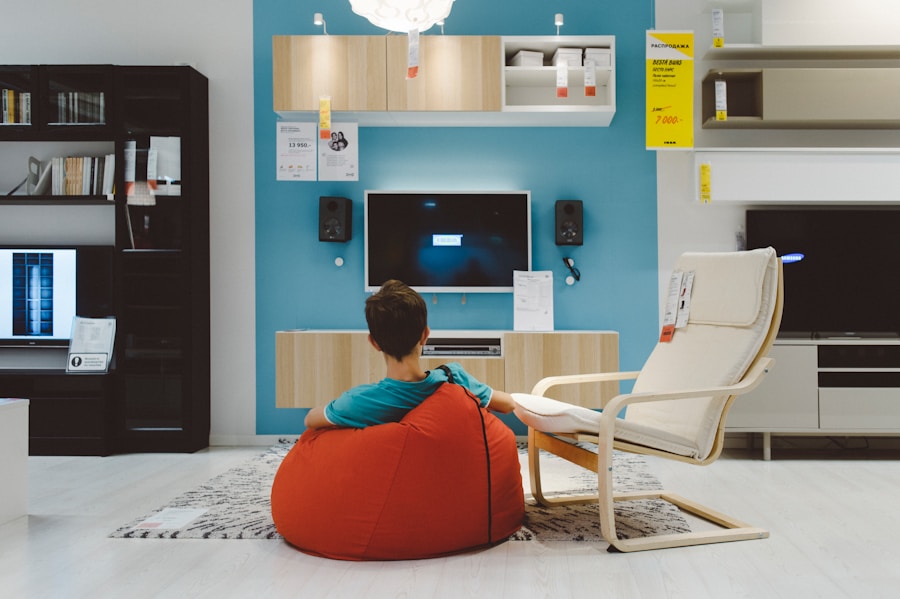In the contemporary workplace, the significance of smart and modern office furniture cannot be overstated. As organizations evolve to meet the demands of a rapidly changing business landscape, the furniture that fills their spaces must also adapt. Modern office furniture is not merely about aesthetics; it plays a crucial role in shaping the work environment, influencing employee morale, and enhancing productivity.
The right furniture can create an atmosphere that fosters creativity and collaboration, while outdated or poorly designed pieces can hinder performance and lead to dissatisfaction among employees. Moreover, the shift towards remote and hybrid work models has further emphasized the need for versatile office furniture. Companies are increasingly investing in furniture that can accommodate various work styles, from collaborative spaces to quiet zones for focused tasks.
This adaptability is essential in attracting and retaining talent, as employees now prioritize workplaces that offer comfort and functionality. Smart office furniture, equipped with features that promote organization and efficiency, is becoming a staple in modern offices, reflecting a commitment to employee well-being and operational effectiveness.
Key Takeaways
- Smart and modern office furniture is important for creating a productive and efficient work environment.
- Ergonomic designs in office furniture are crucial for promoting employee health and productivity.
- Customizable and multi-functional furniture options allow for flexibility and adaptability in the workplace.
- Incorporating technology into office furniture can improve efficiency and streamline work processes.
- Sustainable and eco-friendly office furniture solutions are essential for reducing environmental impact and promoting a healthy workspace.
Ergonomic Designs for Health and Productivity
Designing for Comfort and Support
Ergonomically designed chairs, desks, and workstations are engineered to support the natural posture of the human body, reducing the risk of musculoskeletal disorders that can arise from prolonged sitting or improper alignment. Adjustable chairs that allow users to modify seat height, backrest angle, and armrest position can significantly enhance comfort during long hours of work.
Boosting Productivity and Efficiency
This attention to ergonomic detail not only promotes physical well-being but also contributes to higher levels of concentration and efficiency. In addition to individual pieces of furniture, the overall layout of an office can also benefit from ergonomic principles. Desks that are adjustable in height allow employees to alternate between sitting and standing throughout the day, which has been shown to improve energy levels and reduce fatigue.
Creating a Healthier Work Environment
Furthermore, incorporating elements such as keyboard trays and monitor stands can help maintain proper alignment and reduce strain on the eyes and neck. By prioritizing ergonomic designs, companies can create a healthier work environment that ultimately leads to increased productivity and job satisfaction.
Customizable and Multi-functional Furniture Options

The demand for customizable and multi-functional office furniture has surged as businesses seek to maximize their space while catering to diverse employee needs. Customizable furniture allows organizations to tailor their workspaces according to specific requirements, whether it’s accommodating a growing team or creating distinct areas for different tasks. For instance, modular desks that can be reconfigured easily enable teams to collaborate more effectively or create private workstations as needed.
This flexibility is particularly valuable in dynamic work environments where team structures may change frequently. Multi-functional furniture also plays a pivotal role in optimizing office space. Desks that double as storage units or conference tables that can be transformed into collaborative workspaces exemplify this trend.
Such designs not only save space but also reduce clutter, contributing to a more organized and efficient work environment. Additionally, these versatile pieces can be aesthetically pleasing, allowing companies to maintain a modern look while ensuring functionality. By investing in customizable and multi-functional options, businesses can create adaptable spaces that meet the evolving needs of their workforce.
Incorporating Technology into Office Furniture
The integration of technology into office furniture has revolutionized the way we work, making it more efficient and connected than ever before. Smart desks equipped with built-in charging ports, wireless charging pads, and integrated cable management systems are becoming increasingly common in modern offices. These features not only streamline the workspace but also reduce distractions caused by tangled cords and low battery notifications.
Furthermore, some desks now come with touch-screen interfaces that allow users to adjust height settings or monitor their sitting time, promoting healthier work habits. In addition to individual pieces of furniture, entire office environments are being enhanced through technology. For example, collaborative spaces may feature interactive whiteboards or digital displays that facilitate brainstorming sessions and presentations.
The rise of remote work has also led to the development of furniture designed for video conferencing, such as conference tables with built-in cameras and microphones. This technological integration fosters seamless communication among team members, regardless of their physical location. As technology continues to advance, the potential for innovative office furniture solutions will only expand, further transforming the workplace experience.
Sustainable and Eco-friendly Office Furniture Solutions
As environmental concerns become increasingly pressing, the demand for sustainable and eco-friendly office furniture solutions has gained momentum. Companies are recognizing the importance of reducing their carbon footprint and are seeking furniture made from sustainable materials such as reclaimed wood, recycled metals, and low-VOC (volatile organic compounds) finishes. These materials not only minimize environmental impact but also contribute to healthier indoor air quality for employees.
Moreover, sustainable office furniture often emphasizes durability and longevity, reducing the need for frequent replacements. For instance, well-crafted pieces made from high-quality materials can withstand years of use without showing significant wear and tear. This focus on sustainability aligns with broader corporate social responsibility initiatives, allowing companies to demonstrate their commitment to environmental stewardship while also appealing to eco-conscious consumers and employees.
By investing in sustainable office furniture solutions, organizations can create a workspace that reflects their values while promoting a healthier planet.
Creating Collaborative and Flexible Workspaces

The modern workplace is increasingly characterized by collaboration and flexibility, necessitating furniture designs that support these dynamics. Open-plan offices have become popular as they encourage teamwork and communication among employees. However, this layout requires careful consideration of how furniture is arranged to facilitate collaboration while minimizing distractions.
Collaborative workspaces equipped with comfortable seating arrangements and movable tables allow teams to gather easily for brainstorming sessions or project discussions. Flexibility in workspace design is also essential for accommodating various work styles. Furniture that can be easily reconfigured enables organizations to adapt their spaces based on current projects or team sizes.
For example, lightweight chairs and tables that can be moved around facilitate quick transitions between individual work and group activities. Additionally, incorporating quiet zones with sound-absorbing materials provides employees with spaces for focused tasks when needed. By prioritizing collaborative and flexible workspace designs, companies can foster a culture of innovation while meeting the diverse needs of their workforce.
Enhancing Employee Well-being with Smart Office Furniture
The well-being of employees is paramount in today’s workplace culture, and smart office furniture plays a significant role in promoting this aspect. Features such as adjustable lighting systems integrated into desks or ambient lighting options can create a more comfortable atmosphere conducive to productivity. Furthermore, some smart furniture solutions include built-in wellness reminders that encourage employees to take breaks or stretch throughout the day, combating the negative effects of prolonged sitting.
Additionally, incorporating biophilic design elements—such as planters or natural materials—into office furniture can enhance employee well-being by creating a connection to nature. Studies have shown that exposure to natural elements can reduce stress levels and improve overall mood among employees. By investing in smart office furniture that prioritizes well-being, organizations not only enhance employee satisfaction but also boost overall productivity and engagement within the workplace.
Trends and Innovations in Modern Office Furniture
The landscape of modern office furniture is continually evolving, driven by trends that reflect changing work habits and technological advancements. One notable trend is the rise of remote work solutions that cater specifically to home offices. As more employees opt for hybrid or fully remote arrangements, companies are investing in ergonomic home office setups that mirror the comfort and functionality of traditional office environments.
Another innovation gaining traction is the use of artificial intelligence (AI) in office furniture design. AI-driven analytics can help organizations understand how employees interact with their workspace, leading to data-informed decisions about layout and furniture selection. Additionally, advancements in materials science are paving the way for lighter yet more durable furniture options that are easier to move and reconfigure.
Sustainability continues to be a driving force behind innovations in office furniture design as well. Manufacturers are increasingly exploring new eco-friendly materials and production methods that minimize waste while maximizing functionality. The integration of smart technology into furniture pieces is also on the rise, with features designed to enhance user experience through connectivity and automation.
As these trends continue to shape the future of office environments, businesses must remain agile in adapting their spaces to meet evolving needs while fostering a culture of innovation and collaboration among their teams.
If you are looking for innovative office desk designs to complement your smart and modern office furniture, you should check out this article on innovative office desk designs. This article provides insights into how to choose the perfect height adjustable desk to enhance productivity and comfort in the workplace. With a focus on functionality and aesthetics, these desk designs can help create a more efficient and stylish office environment.
FAQs
What are the benefits of using smart and modern office furniture?
Using smart and modern office furniture can improve productivity, create a more comfortable work environment, and enhance the overall aesthetic of the office space. Additionally, modern office furniture often incorporates ergonomic designs, which can help reduce the risk of workplace injuries and improve employee well-being.
What features are typically found in smart office furniture?
Smart office furniture often includes features such as built-in charging stations, integrated technology connectivity, adjustable height settings, and customizable configurations. These features are designed to enhance functionality and adapt to the evolving needs of the modern workplace.
How does modern office furniture contribute to a sustainable workplace?
Many modern office furniture designs prioritize sustainability by using eco-friendly materials, incorporating energy-efficient features, and promoting modular and adaptable layouts that can reduce the need for frequent furniture replacements. This can help businesses reduce their environmental impact and contribute to a more sustainable workplace.
What are some popular materials used in modern office furniture?
Popular materials used in modern office furniture include sustainable wood, metal, glass, and recycled materials. These materials are often chosen for their durability, aesthetic appeal, and eco-friendly properties, aligning with the modern office’s emphasis on sustainability and functionality.
How can smart office furniture contribute to a more collaborative work environment?
Smart office furniture can be designed to facilitate collaboration by offering flexible seating arrangements, integrated technology for seamless communication, and modular configurations that can be easily reconfigured for group meetings or collaborative projects. This can help foster a more dynamic and interactive work environment.


